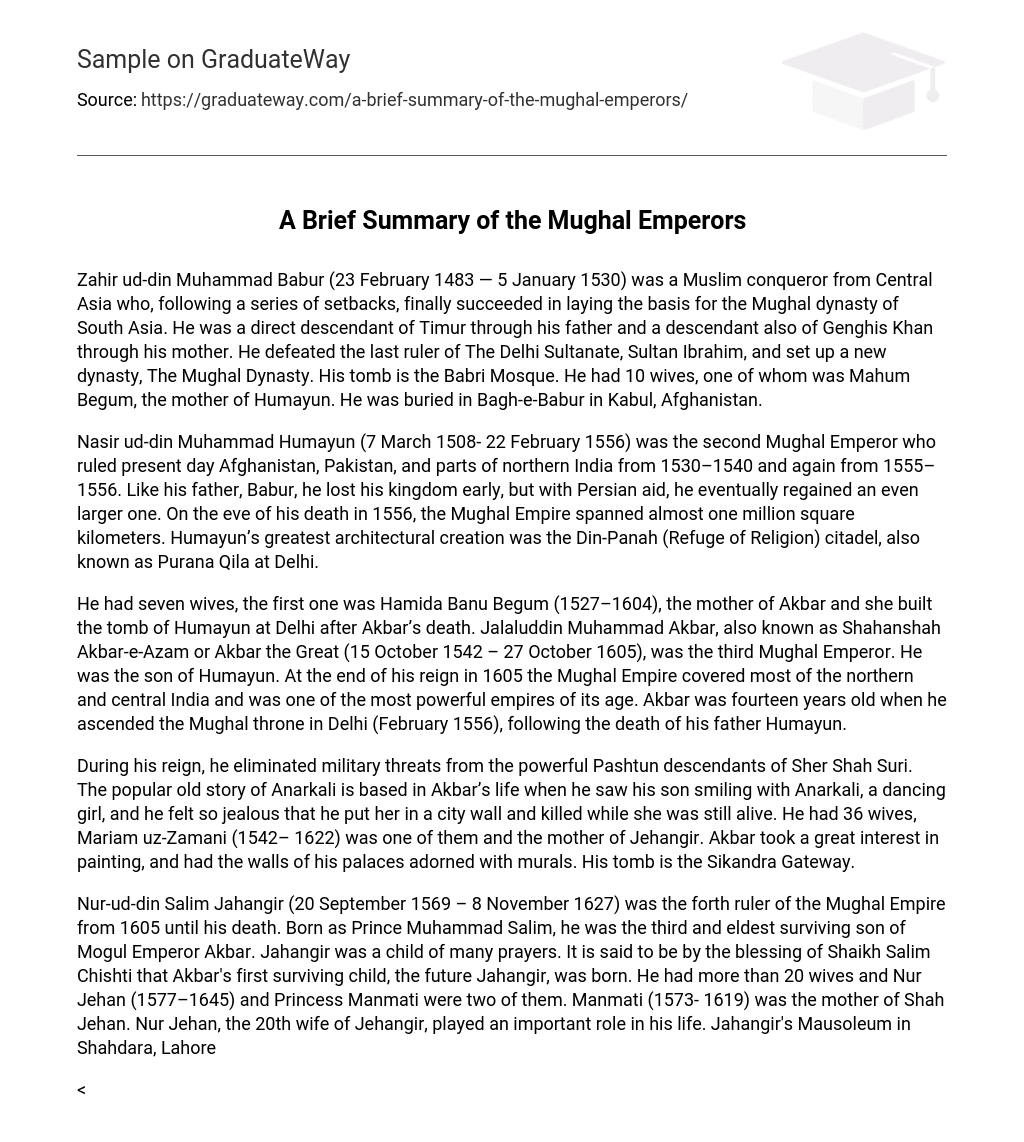Zahir ud-din Muhammad Babur (23 February 1483 — 5 January 1530) was a Muslim conqueror from Central Asia who, following a series of setbacks, finally succeeded in laying the basis for the Mughal dynasty of South Asia. He was a direct descendant of Timur through his father and a descendant also of Genghis Khan through his mother. He defeated the last ruler of The Delhi Sultanate, Sultan Ibrahim, and set up a new dynasty, The Mughal Dynasty. His tomb is the Babri Mosque. He had 10 wives, one of whom was Mahum Begum, the mother of Humayun. He was buried in Bagh-e-Babur in Kabul, Afghanistan.
Nasir ud-din Muhammad Humayun (7 March 1508- 22 February 1556) was the second Mughal Emperor who ruled present day Afghanistan, Pakistan, and parts of northern India from 1530–1540 and again from 1555–1556. Like his father, Babur, he lost his kingdom early, but with Persian aid, he eventually regained an even larger one. On the eve of his death in 1556, the Mughal Empire spanned almost one million square kilometers. Humayun’s greatest architectural creation was the Din-Panah (Refuge of Religion) citadel, also known as Purana Qila at Delhi.
He had seven wives, the first one was Hamida Banu Begum (1527–1604), the mother of Akbar and she built the tomb of Humayun at Delhi after Akbar’s death. Jalaluddin Muhammad Akbar, also known as Shahanshah Akbar-e-Azam or Akbar the Great (15 October 1542 – 27 October 1605), was the third Mughal Emperor. He was the son of Humayun. At the end of his reign in 1605 the Mughal Empire covered most of the northern and central India and was one of the most powerful empires of its age. Akbar was fourteen years old when he ascended the Mughal throne in Delhi (February 1556), following the death of his father Humayun.
During his reign, he eliminated military threats from the powerful Pashtun descendants of Sher Shah Suri. The popular old story of Anarkali is based in Akbar’s life when he saw his son smiling with Anarkali, a dancing girl, and he felt so jealous that he put her in a city wall and killed while she was still alive. He had 36 wives, Mariam uz-Zamani (1542– 1622) was one of them and the mother of Jehangir. Akbar took a great interest in painting, and had the walls of his palaces adorned with murals. His tomb is the Sikandra Gateway.
Nur-ud-din Salim Jahangir (20 September 1569 – 8 November 1627) was the forth ruler of the Mughal Empire from 1605 until his death. Born as Prince Muhammad Salim, he was the third and eldest surviving son of Mogul Emperor Akbar. Jahangir was a child of many prayers. It is said to be by the blessing of Shaikh Salim Chishti that Akbar’s first surviving child, the future Jahangir, was born. He had more than 20 wives and Nur Jehan (1577–1645) and Princess Manmati were two of them. Manmati (1573- 1619) was the mother of Shah Jehan. Nur Jehan, the 20th wife of Jehangir, played an important role in his life. Jahangir’s Mausoleum in Shahdara, Lahore
Shahab-ud-din Muhammad Khurram Shah Jahan (January 5, 1592 – January 22, 1666) was the fifth emperor of the Mughal Empire in India from 1628 until 1658. The name Shah Jahan comes from Persian meaning “King of the World. ” While young, he was a favourite of his legendary grandfather Akbar the Great. He is also called Shah Jehan the Magnificent. Even while very young, he was chosen as successor to the Mughal throne after the death of Emperor Jahangir. He succeeded to the throne upon his father’s death in 1627. He is considered to be one of the greatest Mughal and his reign has been called the Golden Age.
The period of his reign was the golden age of Mughal architecture. Shah Jahan erected many splendid monuments, the most famous of which is the legendary Taj Mahal at Agra built as a tomb for his wife, Empress Mumtaz Mahal. The Pearl Mosque in Agra, the Red Fort in Delhi. He had 3 wives and Mumtaz Mahal (1593 – 1631) was his first wife. Abul Muzaffar Muhy-ud-Din Muhammad Aurangzeb Alamgir, more commonly known as Aurangzeb (4 November 1618 – 3 March 1707 ), also known by his chosen imperial title Alamgir “Conqueror of the World”, was the 6th Mughal Emperor of India whose reign lasted from 1658 until his death in 1707.
Badshah Aurangzeb, having ruled most of the Indian subcontinent for nearly half a century, was the second longest reigning Mughal emperor after the legendary Akbar. In this period he tried hard to get a larger area, notably in southern India, under Mughal rule than ever before. But after his death in 1707, the Mughal Empire gradually began to shrink. Major reasons include a weak chain of “Later Mughals” He built Badshahi Mosque in Lahore. He had 5 wives, and Nawab Raj Bai Begum is one of them.





